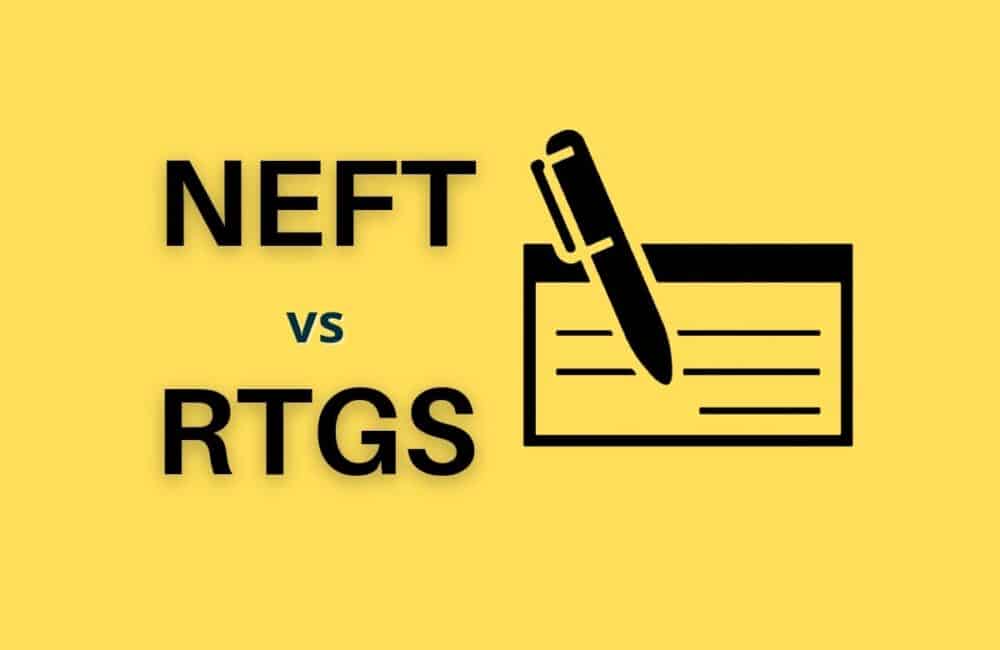The introduction of NEFT and RTGS fund transfer systems by the RBI has created a milestone in the Indian financial setup. They have become the two most preferred digital payments systems. If you are new to online money transactions, knowing the difference between NEFT and RTGS can save you precious time.
What Is National Electronic Fund Transfer?
National Electronic Fund Transfer System or NEFT is an electronic fund transfer system owned and operated by the Reserve Bank of India (RBI). It is a nationwide centralized payment system in which the fund transfer is settled in half-hourly batches.
NEFT does not enable a real-time fund transfer from one bank account in a bank to any other bank branch. However, the fund transfer in NEFT is possible between banks that participate in this payment system.
NEFT payment system provides round-the-clock availability, 365 days a year, and pan India coverage. If you have a savings bank account in any bank in India, the NEFT transactions are completely free.
RBI has given this service to all the participating banks free of charge. This means there is no levy of any charges from participating banks.
Apart from fund transfer, the NEFT system can also be used to pay loan EMI, credit card dues, and all types of inward foreign exchange remittances, etc.
What Is The Real-Time Gross Settlement System?
The acronym ‘RTGS’ stands for Real-Time Gross Settlement. Real-Time Gross Settlement is a fund transfer system based on a gross settlement concept. It enables continuous and real-time settlement of fund transfers. Here real-time means that the amount transferred is credited to the beneficiary account in real-time or without any delay.
RTGS transactions are settled individually on a transaction-by-transaction basis. There is no netting. There is no maximum limit on fund transfers through the RTGS payment system. However, there is a minimum limit of ₹ 2,00,000/-. Hence, the RTGS system is preferred for large value fund transfers.
Difference Between NEFT And RTGS
RTGS and NEFT differ in terms of the procedure of settlement and the amount of money settled. Important points of comparison and difference between NEFT and RTGS are given below:
- Type of Settlement: The settlement in NEFT takes place on a half-hourly basis, while RTGS settlements are based on a real-time basis. Immediate fund transfers in RTGS.
- Service Timings: RTGS, as well as NEFT, are available 365 days 24×7.
- Transaction Charges: There is no charge for inward transactions in NEFT at destination bank branches for receiving money by beneficiary accounts. The maximum charges for outward transactions under NEFT vary bank-to-bank and have been capped by RBI. RTGS allows free inward transactions.
- RTGS outward transactions charge – ₹ 2,00,000/- to 5,00,000/-: not exceeding ₹ 24.50/-; (exclusive of tax, if any). Above ₹ 5,00,000/-: not exceeding ₹ 49.50/- (exclusive of tax, if any).
- Banks have to mandatorily follow the above charges as finalized by RBI. However, they are free to levy lower charges than above.
- Minimum Transfer Value: The minimum transfer value under NEFT transactions is ₹ 1. We can transfer a minimum of ₹ 2 Lacs through RTGS transfers.
- Maximum Transaction Value: No limit in either of the fund transfer systems. However, some banks may impose specific segment-wise limits in NEFT. For cash-based fund transfers, there is a limit of ₹ 50 thousand.
- Payment Option: NEFT and RTGS services are available online as well as offline.
- Suitability: NEFT is suitable for a small amount of fund transfers and RTGS is more preferred for a large amount of money transfers.
- Implementation: RTGS was first introduced in March 2004, while NEFT has been functioning since November 2005. NEFT replaced the Special Electronic Fund Transfer (SEFT) system.
Final Thoughts
Both NEFT and RTGS are inter-bank fund transfer systems devised to serve different categories of customers. While RTGS is based on the gross settlement concept, NEFT works on a net settlement basis. If you want to transfer a large amount of money without any delay, RTGS is a good option. However, if you want to transfer a small amount of money and there are no time constraints, you can choose the NEFT system.
The introduction of NEFT and RTGS systems has positively impacted the growth of digital payments services. It has also created momentum for a cashless economy and is ideal for the goal of financial inclusion in India.
Frequently Asked Questions
What Is The Limit On Funds To Be Transferred Or Remitted Through NEFT?
There is no limit on fund transfer through the NEFT system. The Reserve Bank of India has imposed no limit. However, banks are free to impose individual limits on their customers.
What Are The Benefits Of Using The NEFT System?
NEFT provides near-real-time funds transfers to all participating banks. It is a secure fund transfer system with zero percent charges to savings bank account customers who make online fund transfers. It is available 24×7 and 365 days of the year.
What Are The Operating Hours Of The NEFT System?
NEFT transactions take place in batches at half-hourly intervals throughout the day.
What Are The Timings For RTGS Payments?
With effect from December 14, 2020, RTGS is available 24 hours a day and 7 days a week throughout the year.
How Many Times Can NEFT Fund Transfer Be Done In A Day?
No limit.
Can RTGS Transactions Allow For A Future Date Fund Transfer?
No. future dated transactions are not possible in the RTGS system. It allows only real-time transactions.
Do We Need A Bank Account To Transfer Funds Through NEFT Or RTGS?
If you want to transfer funds through RTGS, you need a bank account. In the case of NEFT, a person having no bank account can also send money. But in this case, there is a maximum limit on such transactions.



